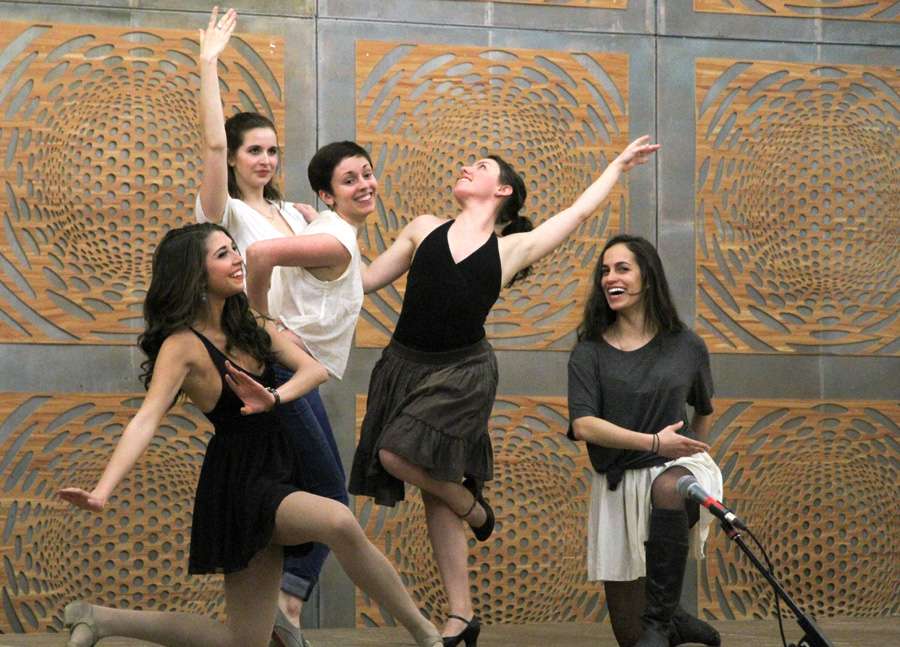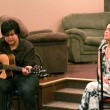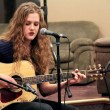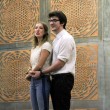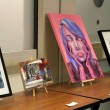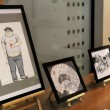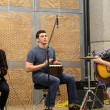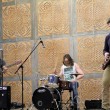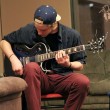There aren’t many places—the Tribune’s Arts & Entertainment section being excepted—where one can find visual art, performance art, interactive art, and live music all together at McGill. In order to reconcile the lack of a formal fine arts program at the school, each year the Arts Undergraduate Society’s (AUS) Fine Arts Council hosts Nuit Blanche, an events showcase featuring different student artists and performers from the McGill community. This year’s theme was Tableau Vivant: “a silent and motionless group of people arranged to represent a scene or incident.”
I began my night in Room 108 of Shatner—the building where Nuit Blanche took place—and immediately noticed Roland Selinger’s interactive art presentation. A screen and projector were set up, allowing artists to free form or just trace along with the images that were displayed. from. This was a fun concept that allowed for visitors to immediately immerse themselves in the artistic mood that dominated the night. The room featured a handful of photographs by Andrew Kittredge and Lucy Ava Liu; the latter’s work caught my eye for its club-pink tint that added an otherworldly effect to a simple photo of a girl standing on the side of the road.
Working upwards through the building, the next stop was the Madeline Parent Room, which housed Fridge Door Gallery’s (FDG) winter vernissage. There were photographs, paintings, drawings, collages, and a projector running a series of pieces against the main wall—not to mention complimentary wine and cheese. FDG’s showing felt like a true art exhibition and was particularly interesting because of the disjointed harmony of all the pieces displayed. While I appreciated the more refined aspect of the vernissage, the setup as a whole seemed oddly removed from the rest of the event, almost as if it had been designed as its own event, only happening to coincide with Nuit Blanche’s exhibition.
Next door to the vernissage was a participatory art exhibit, Liu’s second display of the night. The concept was simple: put two strangers in a room and have them act out a pose for the camera. I decided to participate; I went into the empty room where Liu and another photographer waited and was instructed to chat with my partner while they chose the photo we would be replicating. Though slightly awkward, it was still a fun experience, and afterwards, I spoke with Liu about her inspiration for the project.
“You saw that viral first kiss video that was going around?” asked Liu. “What I didn’t like about it was that it seemed so staged, you could tell each montage was edited to make that element of closeness. I wanted something that was a more real representation of two strangers put into an intimate setting.”
Liu’s approach was to have strangers recreate intimate photos, such as the ones famously taken of David Bowie and Elizabeth Taylor. Even though the poses were staged, they still captured the real performance element of the photo subjects—as long as the subjects didn’t treat it like a joke.
“People take it seriously,” Liu said. “Of course, some people less so than others, and it depends on who the people are and what picture they’re recreating. It’s interesting though, I’ve seen a lot of different reactions.”
There was also a lot of action going on upstairs in the ballroom. I listened as Montreal’s Blank Bullets gave an acoustic performance of songs from their latest EP while simultaneously looking at the works by artists from McGill’s Market Cooperative, an organization which was created to help support local artists from the Montreal area—including designers, jewellery-makers, painters, and bakers.
Nuit Blanche offered a fantastic display of McGill artists working in multiple mediums, and this variety ensured everyone found something they liked. However, Nuit Blanche would have benefited from consolidating the works into fewer rooms. For instance, having more of the visual art displayed in the back of the ballroom where the live music was playing would have allowed for a more inclusive feel, as it seemed that while many styles of art were featured, they were categorized and separated—thus causing an overall fragmented feeling. It was also frustrating that not all of the artists were clearly identified. I find one of the best parts of an exhibition is being able to easily identify and meet the person who painted the portrait that immediately caught your eye.
Despite these minor shortcomings, I can’t deny that just being at the event seemed to be inspiring people to let a little more creativity into their lives. I noticed a few seated people doodling into journals, others were mesmerized by some of the projections in the Madeline Parent Room. When I ended my night in the SSMU lounge watching McGill Improv, I got to see friends and strangers laughing together. Ultimately, it’s always a pleasure to view artwork; and among the rooms full of musicians, craftsmen, painters, poets, photographers, and designers, you were bound to see something you loved.
